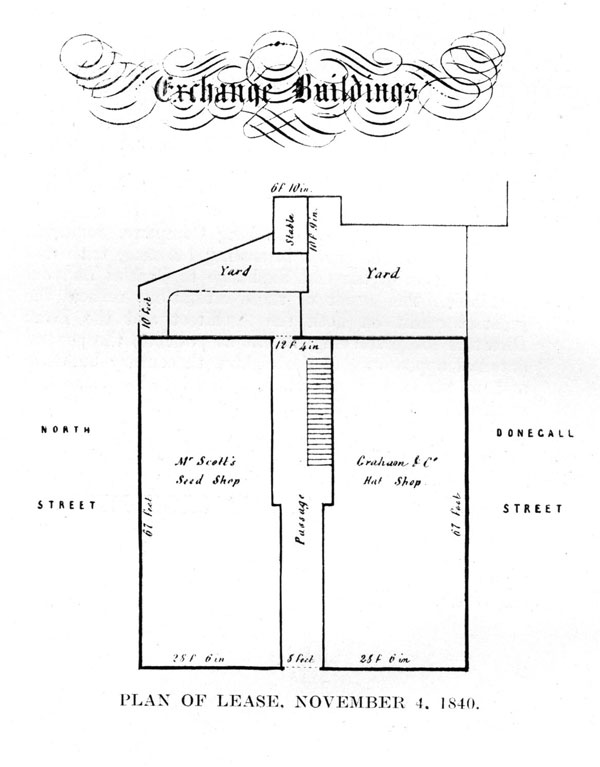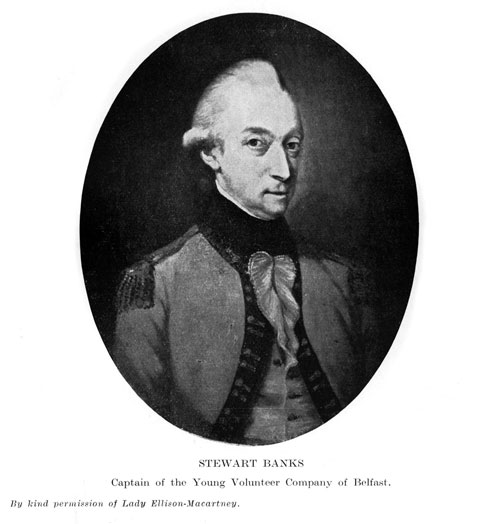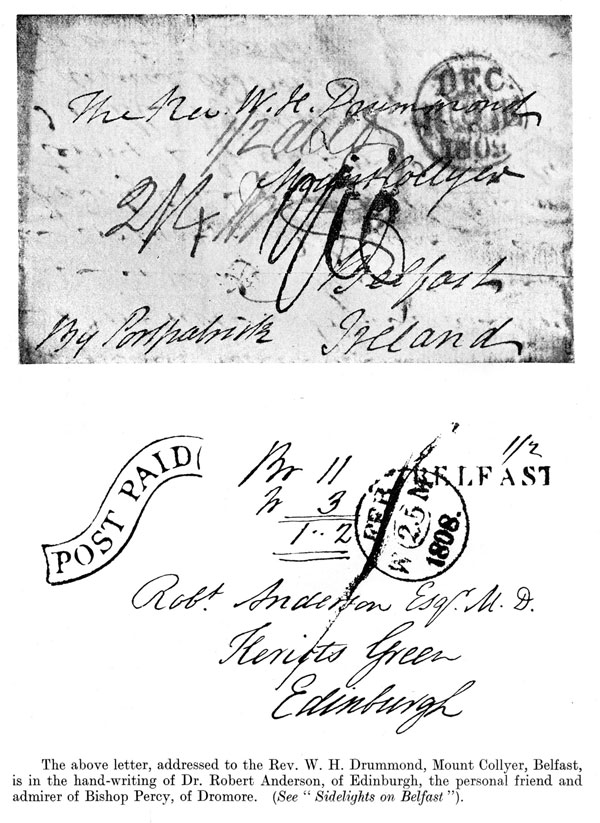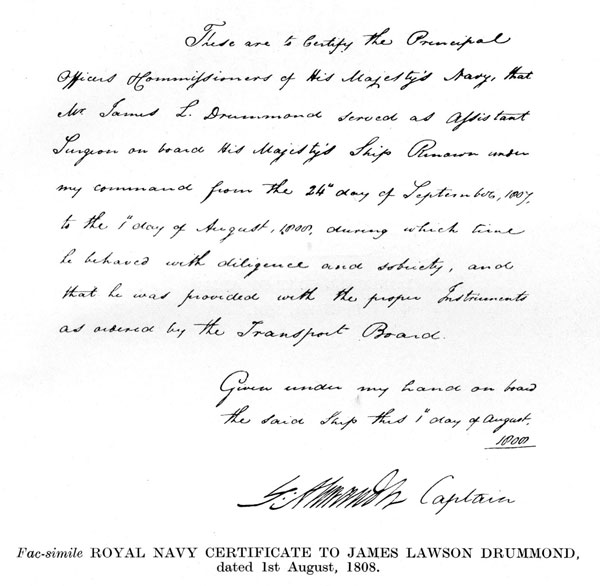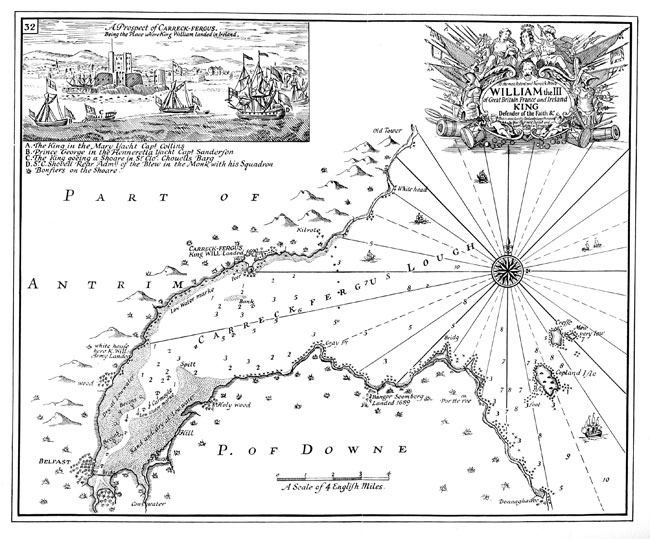ADDENDUM
The following Historical Retrospect was published in March, 1937, as a Pamphlet for Private Circulation and is included as it originally appeared.

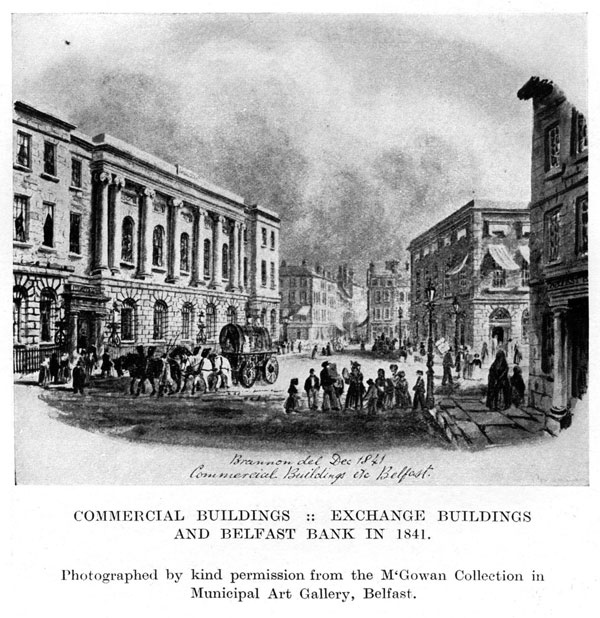
HISTORICAL RETROSPECT:
BELFAST EXCHANGE 1769-1776
EXCHANGE AND ASSEMBLY ROOM 1776-1820
EXCHANGE BUILDINGS 1820-1846
BELFAST BANK 1816 --
BY
S. SHANNON MILLIN, B.A., Barrister-at-Law.
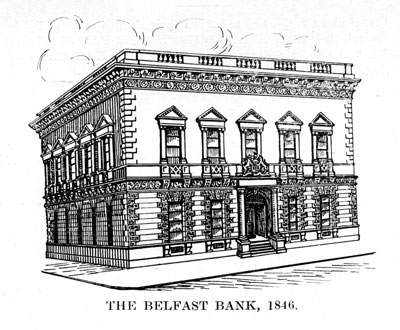
W. & G. BAIRD, LTD., Belfast and London. 1937.
PREAMBLE.
"AN ADDRESS TO THE PUBLIC. The great national movement, for the promotion of IRISH MANUFACTURE, has induced us to take the Extensive Premises, EXCHANGE BUILDINGS, BELFAST, in connexion with our Establishment in 20, Christ Church Lane, Dublin, for the purpose of a Manufactory, and for the Retail Branch of our business...
"We beg most respectfully to return our acknowledgments for the kind favours we have heretofore received at No. 8 Bridge Street; and, having Sold our interest in that concern, which must he closed immediately... "
| GRAHAM & Co., Hat Manufacturers. | |
| 8 Bridge Street, Belfast. | 16th Feb., 1841." |
| Northern Whig, Belfast, February 23, 1841. | |
-- -- -- -- -- -- -- -- --
"H. Graham & Co. beg to inform their Friends and the Public in general, their NEW ESTABLISHMENT, EXCHANGE BUILDINGS, will open for Business on SATURDAY, THE 27th inst. Belfast, March 20th, 1841."
Belfast News-Letter, March 23, 1841.
-- -- -- -- -- -- -- -- --
"The Belfast Bank was at the opposite corner of Donegall Street; where it now stands were the Assembly Rooms, where public balls were given and panoramas exhibited. I saw one of the Siege of Antwerp, at the time a recent exploit." -- Rev. NARCISSUS BATT, A.M. Ulster Journal of Archaeology, 1895.
-- -- -- -- -- -- -- -- --
"NOW OPEN IN THE ASSEMBLY ROOM, EXCHANGE BUILDINGS. Mr. Marshall... has been induced to RE-OPEN... his interesting PANORAMA... displaying... the recent SIEGE of ANTWERP... accompanied by a FULL MILITARY BAND."
Belfast News-Letter, November 17, 1835.
-- -- -- -- -- -- -- -- --
"A NOTABLE ANNIVERSARY: HISTORY OF A GREAT UNDERTAKING.
Centenary of the Belfast Banking Company.
"In 1827 the Commercial Bank... was absorbed and the Belfast Bank's business was formed into a joint stock company on 2nd July, 1827... with the head office, as at present, in Waring Street, in the 'old Exchange' ... "
Belfast News-Letter, July 2, 1927.
-- -- -- -- -- -- -- -- --
" Building on right of old Exchange was, at the beginning of 19th century, a public house called the 'Exchange Tavern'. It was acquired by the Commercial Bank in 1809, and was occupied by it until its amalgamation with the Belfast Bank in 1827, when it was transferred to the' Old Exchange' ... "
CITY OF BELFAST MUSEUM AND ART GALLERY.
Views of Old Belfast, including the McGowan Collection.
(Publication 96. July, 1929).
-- -- -- -- -- -- -- -- --
"The reference to the Belfast Banking Co. on page 34 is not a 'Sidelight on Belfast History' but an ignis fatuus... With regard to Graham & Co., according to Martin's Belfast Directory for 1840-1 the shop of Graham & Co., hatters, was 8 Bridge Street" ... JOHN J. MARSHALL.
Belfast News-Letter, September 23, 1932.
-- -- -- -- -- -- -- -- --
"In the year 1827 the Commercial Bank amalgamated with Gordon, Batt & Co., forming a joint stock company under the title of the Belfast Banking Co. The amalgamated banks, needing increased accommodation, acquired the old Exchange and Assembly Room as new head offices, on which they entered possession July 2, 1827."JOHN J. MARSHALL.
Belfast Telegraph, October 10, 1934.
-- -- -- -- -- -- -- -- --
RETROSPECTIVE.
"If there's a hole in a' your coats,
I rede ye tent it ;
A chiel's amang ye takin' notes,
And, faith, he'll prent it."
R Burns.
The Chapter, entitled "Exchange and Assembly Room ", which appears on pages 29-34 of Sidelights on Belfast History, deals only with the building, and the various uses to which it had been applied, since its erection in 1769, including the alterations made by the Belfast Banking Company in the years 1845-46, prior to their Head Office being opened therein on May 25, 1846.
After a careful examination of title-deeds, kindly placed at my disposal by the Directors, I could find no record of the Company having occupied, earlier than May 25, 1846, the premises known as the Exchange Buildings, formerly Exchange and Assembly Room, as Head Office. There is no document in the possession of the Company to show that they were either yearly tenants or lessees for a term of years, prior to a lease, bearing date October 30, 1843, hereafter more particularly mentioned.
I decided, after a lengthened interview with the Senior Director, Mr. David McKee, to insert what appears on page 34 :-- "On Monday, the 25th of May, 1846, the Bank was opened and has since continued as the Head Office of the Belfast Banking Company." Was the Head Office of the Belfast Banking Company located in the Exchange Buildings earlier than May 25, 1846 ?
Shortly after the publication of Sidelights on Belfast History, I was unable, owing to indisposition to visit Belfast for the purpose of making further investigations; and it was only recently that I had an opportunity of calling again on the Directors, to whom I am indebted, as also to their Solicitor, Mr. Uprichard, for valued assistance.
My second investigation of title confirmed my previous one; but, on this occasion, an Abstract of Title was produced which I had not previously examined. The Abstract had been prepared in 1843 for a contemplated lease, and contained the following :--
"The Belfast Banking Company have agreed with the Donegall family to take a lease from the Marquis of the above-mentioned Exchange Buildings for 61 years at the yearly rent of £200. They mean to improve and fit it up as a Banking House and all the parties interested are willing, as far as they can, to concur in such acts as may be advised necessary for procuring a valid lease."
"The Tenement in question was not in Lease to any Tenant prior to or at the date of the Settlement of 1822, nor at all prior to what appears on this Abstract. It was therefore in the immediate control and possession of the Marquis, the large rooms heing used as Ball Rooms &c. They latterly were set as opportunity offered for Exhibitions &c and underparts of the house as shops -- the income from all which averaged about £300 it year."
The lease, bearing date October 30, 1843, is from George Augustus, Marquis of Donegall, to John Thompson, Thomas Greg Batt, George Thomas Mitchell, and Thomas Hughes, all of Belfast, Bankers, as Public Officers and Directors of the Belfast Banking Company and in trust for themselves and the several other Proprietors of the Stock of the said Company, and the Parcels of that lease are :--
"all that the tenements commonly called the Exchange Buildings bounded... containing in front... all which said tenements and premises are now in the possession of John Thompson, Thomas Greg Batt, George Thomas Mitchell and Thomas Hughes, and are designed as a Banking House for the business of the Belfast Banking Company."
One of the "parties interested" was Thomas Verner, Junior, who had been granted a lease, bearing date July 22, 1842, for a term of 61 years, the Parcels of which are :--
"all that and those that tenement and premises called and known as the Exchange Buildings with the ground on which the same are erected and built... as the said demised premises lately were in the actual possession of the said Marquis but now in the possession of the said Thomas Verner Junior except that portion now in the possession of Messrs. Scott Brothers and are more particularly described (as to their Buttels and Boundaries) in the plan or ground plot thereof hereupon laid down or hereunto annexed and are situate, lying, and being in the Town of Belfast, Parish of Shankill, Barony of Belfast and County of Antrim."
As the premises "called and known as the Exchange Buildings" were in possession of Thomas Verner and Scott Brothers in 1842, it follows that the Belfast Banking Company were not in possession of the premises at that date.
The portion of the premises in occupation of Scott Brothers had been granted by lease, bearing date November 4, 1840, to William Trousdale, of Belfast, Custom House Officer for a term of 21 years, and described in the Parcels as :--
"all that shop tenement messuage and premises with the yards adjoining thereto on the ground floor of the Exchange Buildings as now in the actual occupation and possession of Scott Brothers."
and four years later, March 17, 1844, he, William Trousdale, conveyed the remainder of his leasehold interest in said premises to the Belfast Banking Company.
The leasehold interest of Scott Brothers was assigned to the Belfast Banking Company by a deed, bearing date, May 1, 1844.
From the foregoing recitals we can now state definitely that the Head Office of the Belfast Banking Company was not in the Exchange Buildings prior to May, 1844. But the question still remains --
Where was the Head Office of the Company from the date of its formation on July 2, 1827?
The following announcements appeared in the local papers, with their respective dates :--
"BELFAST BANKING COMPANY. A GENERAL MEETING of the Proprietors of Stock of said Company will be held at their Banking House, Donegall Street, on Saturday the 4th August next at Twelve o'clock for the purpose of electing a Board of Superintendence, agreeably to the Deed of Partnership.
Present Commercial Bank. Belfast 16th July, 1827."
Belfast News-Letter, July 27, 1827.
-- -- -- -- -- -- -- -- -- -- --
"BELFAST BANKING COMPANY. We understand the office of the Belfast Banking Company was opened for public business on Wednesday morning... The office of the concern, late the Commercial Bank, is in a most central situation, being in the centre of the business part of the town."
Belfast News-Letter, Friday, August 3, 1827.
-- -- -- -- -- -- -- -- -- -- --
"BELFAST BANKING COMP ANY. The first general meeting of the Company was held on Saturday last, at their Banking-house, Donegall-street, for the purpose of electing a Board of Superintendence. Narcissus Batt Esq. was called to the Chair. The meeting then proceeded to an election, by ballot, of six proprietors, who, with R Calllwell, Esq., Auditor of Accounts, nominated by the deed of partnership, form the Board of Superintendence. The following gentlemen were chosen, viz.:
| Narcissus Batt Esq. | Hugh McCalmont Esq. |
| Wm. Tennent Esq. | Edw. Curteis Esq. |
| Geo. Langtry Esq. | John McCracken Esq. |
Belfast News-Letter, Tuesday, August 7, 1827.
From the foregoing announcements it is evident that the Belfast Banking Company occupied as "their Banking-house, Donegall-street" the premises "late the Commercial Bank." But the question still remains -- How long did the Company occupy those premises? The answer to that question will be found in the following newspaper announcements.
"THE BELFAST BANKING COMPANY. ON AND AFTER THE 25th inst., the business will be conducted in their New Building. Belfast, 22nd May, 1846."
Northern Whig, Belfast, May 23,1846.
-- -- -- -- -- -- -- -- -- -- --
"BELFAST BANKING COMPANY. Yesterday, this Company took possession of their elegant new premises, built on the site of the former Exchange in this town..."
Belfast News-Letter, Tuesday, May, 26, 1846.
-- -- -- -- -- -- -- -- -- -- --
"Belfast Banking Company. On Monday last, the Belfast Banking Company removed the public business of their establishment to the extremely handsome and commodious premises formerly known as the Exchange... "
Belfast Commercial Chronicle, Wednesday, May 27, 1846.
-- -- -- -- -- -- -- -- -- -- --
"NEW OFFICE OF THE BELFAST BANKING COMPANY. Last week, the Directors and other Officers of the Belfast Banking Company took possession of their new office. The premises are those formerly known as 'the Exchange'."
Northern Whig, Belfast, June 2, 1846.
-- -- -- -- -- -- -- -- -- -- --
We can now state definitely (1) the Belfast Banking Company opened their office, "late the Commercial Bank," on August 1, 1827; (2) the first General Meeting of the Company, for the purpose of electing a Board of Superintendence, was held on Saturday, August 4, 1827; (3) the public business of the Company was removed to the premises, "formerly known as the Exchange", on Monday, May 25, 1846, after almost twenty years' occupation of the premises at the corner of Waring Street and Donegall Street.
Let us now consider the premises on the east side of Donegall Street, occupied by the Belfast Commercial Bank from 1809 till 1827 and by the Belfast Banking Company from 1827 till 1846. When the second Brown Linen Hall was built (1754) on the ground now occupied by the Cathedral of St. Anne, a new street was formed on the north side of Waring Street, called at first Linnenhall Street, afterwards Donegall Street. The old houses on the north side of Waring Street, from the corner of North Street to "Bullers entrance" (i.e. the entrance to Bullers Field) shown on Maclanaghan's Map of 1715, were pulled down, and a lease, bearing date May 14, 1755, was granted to James Hamilton for a term of 41 years, the Parcels of which, as shown more particularly in a Mortgage of the premises in 1763, are :--
"all that piece or parcel of ground with the messuage or tenement and building thereon, bounded on the E. with a tenement in the tenure of Rigby Dobbin, and on the W. with a street called Linnenhall Street, containing in front to Broad Street 48 feet and extending backwards 136 feet."
By a deed, bearing date October 4, 1794, Thomas Milliken granted a lease to James Hyndman for 21 years at £18 4s. 0d. per annum, the Parcels of which are :--
"all that tenement and front shop situate on the E side of Donegall Street and corner of Waring Street, containing in front to Donegall Street 18 feet and extending backwards in depth along Waring Street 24 feet, as the same is now in the possession of James Hyndman."
James Hyndman, by a deed, bearing date February 21, 1803, after reciting an original lease for 50 years from May, 1801, assigned, in consideration of £345, to Christopher Strong, his leasehold interest in the said premises. Three years later, by deed, bearing date August 29, 1806, Christopher Strong conveyed his leasehold interest in said premises to William Blackwell for the yearly rent of £98 11s. 10d.
It should be noted, for reasons which will appear later, that the "tenement and front shop" are described as being on the "E side of Donegall Street."
By a deed, bearing date February 21, 1809, William Blackwell, in consideration of £568 15s. Od., assigned to William Tennent, R Callwell, R Bradshaw, John Cunningham, John Thompson, Jennymount, and John Stewart, Wilmont, his leasehold interest in
"all that dwelling-house or messuage situate on the E. side of Donegall Street and corner of Waring Street... as the same were formerly in the possession of James Hyndman, late of William Blackwell, and now of the said William Tennent... "
"To Hold to the said William Tennent... as tenants in common and not as joint tenants from February 1 now instant for all the residue of the term of 45 years granted by the original lease of said premises from Christopher Strong to the said William Blackwell subject to the yearly rent of £98 15sh. payable Half Yearly."
William Tennent, R Callwell, R Bradshaw, John Cunningham, John Thompson, and John Stewart were the Partners in the Belfast Commercial Bank, opened (1809) in the aforesaid premises, of which they were the lessees.
They were still the lessees in 1827 when the Belfast Commercial Bank and the Belfast Bank, availing themselves of 6 Geo. IV. c. 42, signed a Deed of Partnership, bearing date July 2, 1827, which, after reciting
"The several parties hereto have come to an agreement for the purpose of establishing a Joint Stock Banking Company in the Town of Belfast."
"At and prior to the passing of the said Act "(6 Geo. IV. c. 42) " two partnerships of Bankers had been carried on in the Town of Belfast under the respective names of Commereial Bank and Belfast Bank"
appointed Thomas Batt, James Luke, John Thompson, and Thomas Greg Batt as Directors.
It must not be imagined that the Belfast Commercial Bank was absorbed by the Belfast Bank, or that the Belfast Bank was the pioneer in establishing the new Joint Stock Banking Company. Of the four Directors and seven members of the Board of Superintendence there were four representatives of the Belfast Commercial Bank, three representatives of the Belfast Bank, while the remaining four were representatives of the outside commercial community.
It should be mentioned that the name was Belfast Commercial Bank, as shown on their Bank Note, and not, as it is often miscalled, Commercial Bank; also that John Stewart, of Wilmont, was an original Director, but he, as Benn points out in his 1880 History, "retired from it in consequence of some disagreement with his co-directors ". His name is given as one of the Directors in Smyth's Belfast Almanack, 1813.
In Bradshaw's Belfast Directory for 1819, under the heading of Bankers, and also in Smyth's Belfast Almanack for 1826, under the heading of Banks, there appears :-- "Belfast Commercial Bank, No. 1 Donegall Street" ; and on Mason's Map of Belfast which appears in Smyth's Belfast Almanack for 1820, the Belfast Commercial Bank is at the corner of Donegall Street and Waring Street.
In Martin's Belfast Directory, 1842-43, there appears :
"EXCHANGE BUILDINGS:
Scott Brothers, nursery and seedsmen ;
Graham & Co., hatters and manufacturers.
-- -- -- -- --
2 WARING STREET :
Belfast Bank."
That the Belfast Bank was then situate at the corner of Donegall Street and Waring Street is confirmed by a Water Colour Drawing by Phillip Brannon, with the artist's inscription : "Brannon del Dec. 1841 Commercial Buildings etc. Belfast." The Building, incomplete in the Drawing, at the corner of Donegall Street and Waring Street, has the letters BELFAST BAN over the doorway, while several customers are emerging from Graham & Co.'s Hat Shop in the Exchange Buildings. Although the Drawing is dated "Dec. 1841", it is clearly a midsummer view.
The original entrance to Belfast Commercial Bank, afterwards Belfast Bank, was 1 Donegall Street. But in Martin's Belfast Directory, 1840-41, 1841-42, and 1842-43, the Belfast Bank is not mentioned as being on the E. side of Donegall Street. It appears, as already stated, at :2 Waring Street. It may thus be inferred that the entrance to the Bank was changed in order that the Donegall Street frontage could he utilised for commercial purposes.
The Exchange was erected as a one-storied building (1769), having five doors or gateways on each of three sides. Seven years later (1776) a second floor was added, subsequently known as the Assembly Room. Benn, writing in 1823, says :--
"The Exchange was founded in 1769. It is built of brick, partially ornamented in front with cut stone, and possesses but little architectural beauty. There is a piazza on the ground floor, and above is a very elegant and spacious apartment, generally used either as an assembly room, for the town meetings, or for public exhibitions. There is no propriety whatever in continuing to distinguish this building by the name of the Exchange, as it is not at present applied to any mercantile purpose."
The Commercial Buildings were opened in 1820, the foundation stone having been laid in the previous year by George Augustus, Marquis of Donegall. A few years later the ground floor or piazza of what formerly had been used as an Exchange was converted into shops, when the Assembly Room became known as Assembly Room, Exchange, to distinguish it from the Assembly Room, Commercial Buildings. Henceforward the two-storied building, hitherto known as Exchange and Assembly Room, became Exchange Buildings and retained the name till 1846, when the name was again changed to Belfast Bank, by which name it is still known. That name must not, however, be confused with the name of the owners, Belfast Banking Co., Ltd.
By kind permission of the Directors, I am enabled to reproduce the Plan endorsed on a lease, bearing date November 4, 1840, in the possession of Belfast Banking Co., Ltd., and which supplies much topographical information. Graham & Co.'s Hat Shop, opened for retail business on Saturday, 27th March, 1841, has a frontage to Donegall Street of 67 feet; Mr. Scott's Seed Shop has a frontage to North Street of 67 feet; and in the centre of the south front, facing Bridge Street, there is an opening of 8 feet in width, increasing to 12 feet 4 inches towards the rere. In this wider passage there is indicated a stairway, leading to the Assembly Room on the first floor, wherein was many a festive scene of youth and beauty; and wherein, also, was pronounced the death sentence of the misguided youth, Henry Joy M'Cracken, who on the evening of July 17, 1798, was publicly hanged at the Market House, corner of High Street and Corn Market.
The Belfast Bank, situated at what was, prior to the middle of the 18th century, the Four Corners, a name used long after Donegall Street was opened in 1754, is the sole survivor of the buildings erected through the generosity of Arthur, 5th Earl and 1st Marquis of Donegall who recites in a legal document that he
"laid out and expended in erecting public buildings in the Town of Belfast... the sum of £20,000 and upwards."
As I have stated in Sidelights on Belfast History :--
"In 1845 the Belfast Banking Company, requiring larger premises for their increasing business, entrusted the alteration of the Old Exehange to Charles Lanyon, Architect. The result of those alterations reflects the greatest credit on both the Architect and the Bank Directors for preserving, as far as possihle, the general external appearnce of the eighteenth century building, and, at the same time, retaining the interior deeorative work of Sir R Taylor."
S. SHANNON MILLIN.
Harpenden,
March, 1937.
